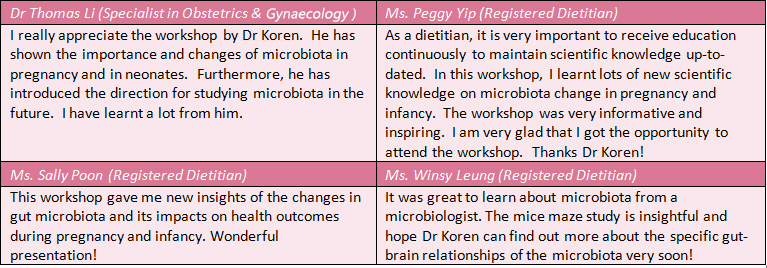At the 4th Child Nutrition Advisory Group (CNAG) expert workshop held in April 2018 and chaired by Dr Thomas Li (Specialist in Obstetrics & Gynaecology and CNAG Chairman, Hong Kong), Dr Omry Koren shared his clinical research insights on how the gut microbiome may be associated with pregnancy and infant health outcomes.
Dr Omry Koren
Azrieli Faculty of Medicine,
Bar Ilan University,
Safed, Israel
Relations between pregnancy and gut microbiome
Metabolic changes during a healthy pregnancy are similar to aspects of metabolic syndrome that can be triggered by microbiome dysbiosis1. Along with weight gain and insulin desensitization, there is microbiota alteration along the journey of pregnancy.1

Influencing factors on gut microbiota composition
Each body site has a unique microbiota, where a newborn’s microbiota generally correlates with the delivery mode4. Subsequently, there is a timeline of gut colonization by microbes following changes in the baby’s diet5. Another important influencing factor is the use of antibiotics. Through the observation of mice behavior in open fields and mazes, a recent study has found the impact of antibiotic treatment on gut microbiota is associated with changes in behavior, such as anxiety and risk taking6. These study results highlight the importance of gut-brain axis, and the association of antibiotic treatments with significant long-term behavioural changes.
Implications
Continuous mapping of the gut microbiome allowed understanding on the potential influencing factors and determinants of a healthy pregnancy and optimal infant health, providing possible intervention points based around the modulation of gut microbiota. It may be important to support a thriving gut microbiota in pregnant women, and the decision on antibiotic treatments in infants should be substantiated with the understanding of potential long-term effects.
Comments from CNAG members who attended the expert workshop

References
1. Koren O, et al. Cell. 2012;150(3):470-80.
2. Hold GL, et al. World J Gastroenterol. 2014;20(5):1192-210.
3. Torrazza RM, et al. PLoS One. 2013;8(12):e83304.
4. Dominguez-Bello MG, et al. Proc Natl Acad Sci U S A. 2010;107(26):11971-5.
5. Laursen MF, et al. Front. Microbiol. 2017;8:356.
6. Leclercq S, et al. Nat Commun. 2017;8:15062.
